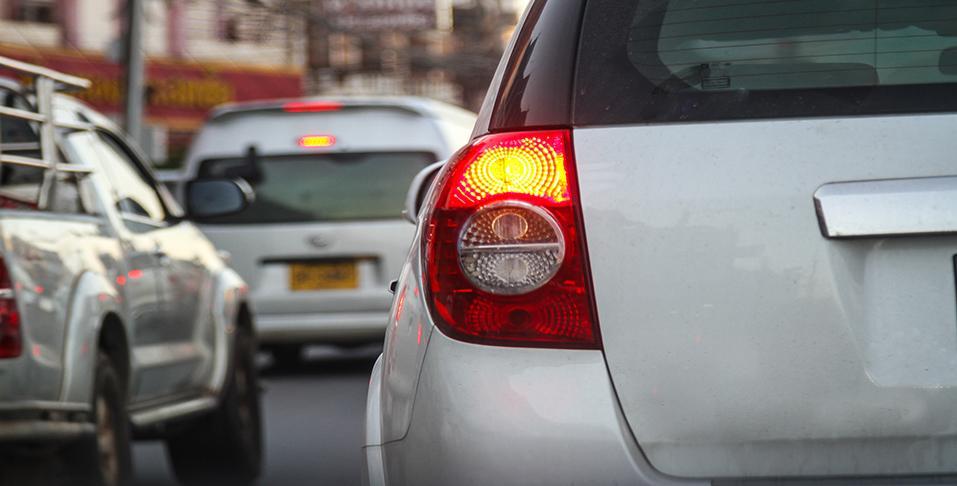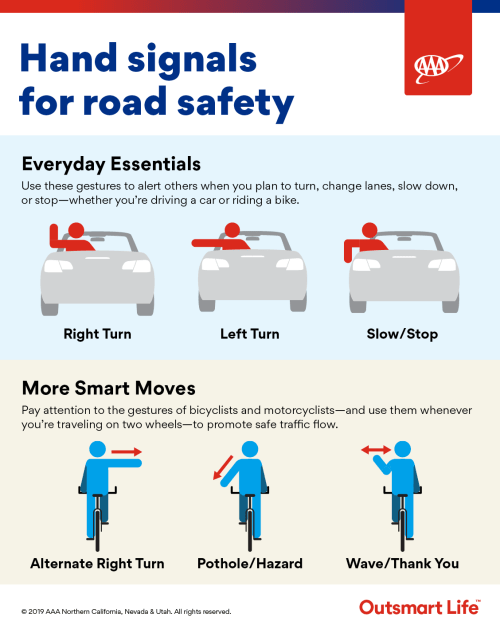The Original Turn Signals

Pictured above is a photo I pulled from a Google search, originally from a website that sells LED bulbs. We probably take such innovations for granted today; there are LEDs basically everywhere. And in many cases, they help make our world a bit safer. The yellowish light above is a great example. That’s a turn signal: if that light is blinking, it means that the driver of the car is intending to turn left or move over into the left lane. As part of driving is anticipating what other drivers will do, that’s good information to have — turn signals help prevent accidents.
But LEDs have only been around since the 1960s, and cars — and car crashes — definitely predate them. So what did we use for turn signals before we had bulbs?
In many cases, these:

Yep: a pair of white gloves.
For more than a century, drivers (and more commonly today, bicyclists) have had a non-electronic way to signal their intent to others on the road: hand signals. As seen in the hand infographic below from AAA, there’s a code you can use to tell others what you’re about to do next.

It’s an effective solution, one still used today. (As AAA notes, you may have to use this system in some cases: “anyone operating a vehicle with a broken, missing, or obscured turn signal is required by law [in the United States] to use hand signals when changing lanes or turning.”) But before car blinkers, we also didn’t have really great street lights. After sundown, hand signals are less effective.
Enter white gloves. As the Japan Times reported, “before trains and automobiles had automatic signals, those at the controls had to use their hands to signal their moves, and white gloves make the hands easier to see.” And the trend isn’t limited to Japan. For example, in October 1920, the Washington Herald reported that the police captain “requests each [Washington, D.C.] motorist to purchase a pair of white gloves and wear them after dark.” It was an inexpensive solution, too: the captain, per the newspaper, noted that the gloves only cost ten cents a pair — about $1.50 in today’s dollars — and if you’re being particularly frugal, “it is only necessary that one [glove] be worn.” You can find other examples throughout newspapers in the 1920s: here are examples from the Chicago Tribune, the Billings (Montana) Gazette, the Vancouver Sun in Canada, and the Birmingham Post (England).
The trend of white gloves drivers faded over time as technology rendered them unnecessary, but you’ll still see one example remaining; as USA Today reports, while optional, taxi drivers in Tokyo still tend to wear them (albeit mostly out of a sense of formality, not traffic safety.)
Bonus fact: On TV and in movies, museum curators are often wearing white gloves while handling historic documents or old pieces of art. But they probably shouldn’t be. As Art History News explains, “gloves are in fact more or less useless, and if anything more likely to cause damage, especially with old documents and works on paper,” and as of 2012, “at the National Archives [in the UK], staff and readers do not wear white gloves when handling material, except when on TV. They are so weary of people writing in complaining if white gloves are not used, that they make an exception when the cameras are rolling.” For newer TV programming, that’s probably not the case: in 2013, the National Archive issued a policy (blog summary here, pdf here) that concluded “the disadvantage of wearing gloves outweigh the advantages,” and suggest that gloves not be used except for in specific situations.
From the Archives: Mr. Pee Hands: Most baseball players wear gloves to help them grip the baseball bat. Some don’t, and in some cases, the reason is gross.
